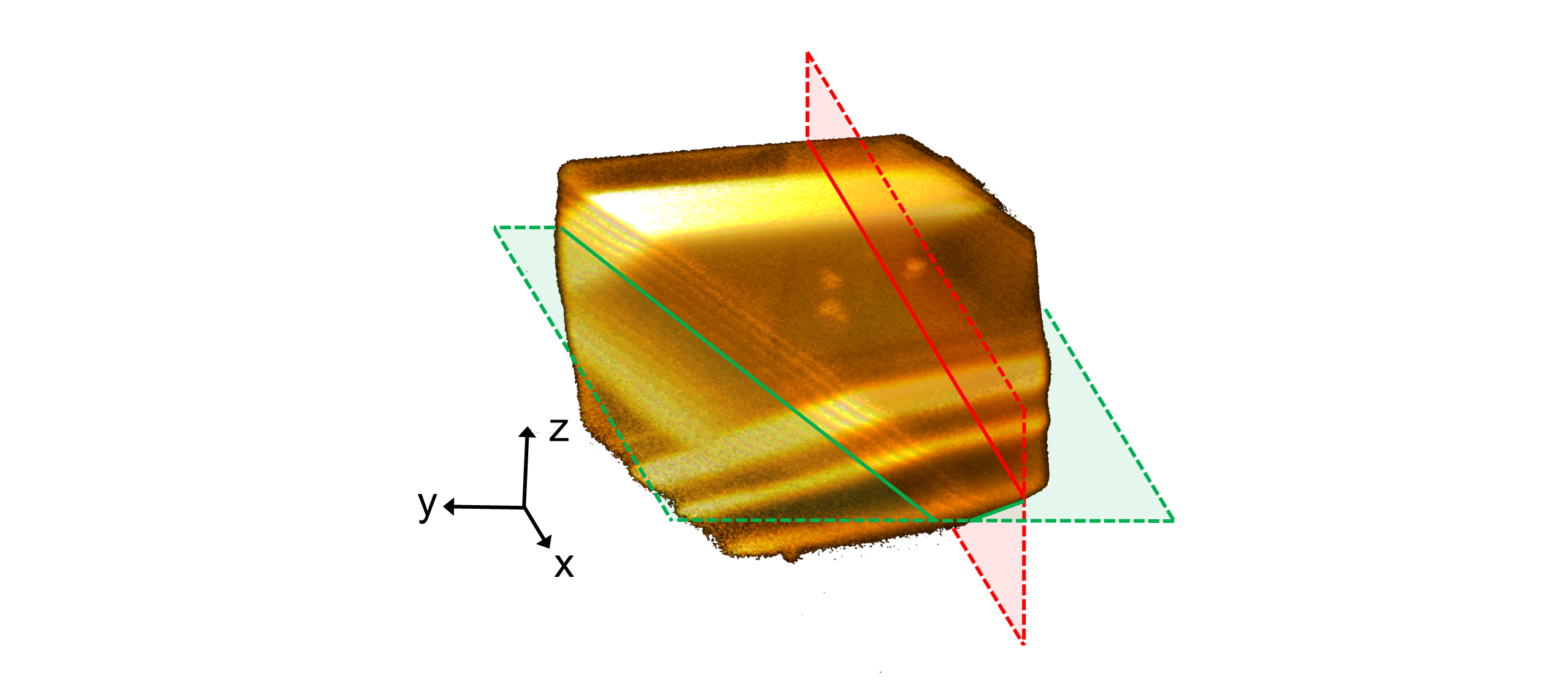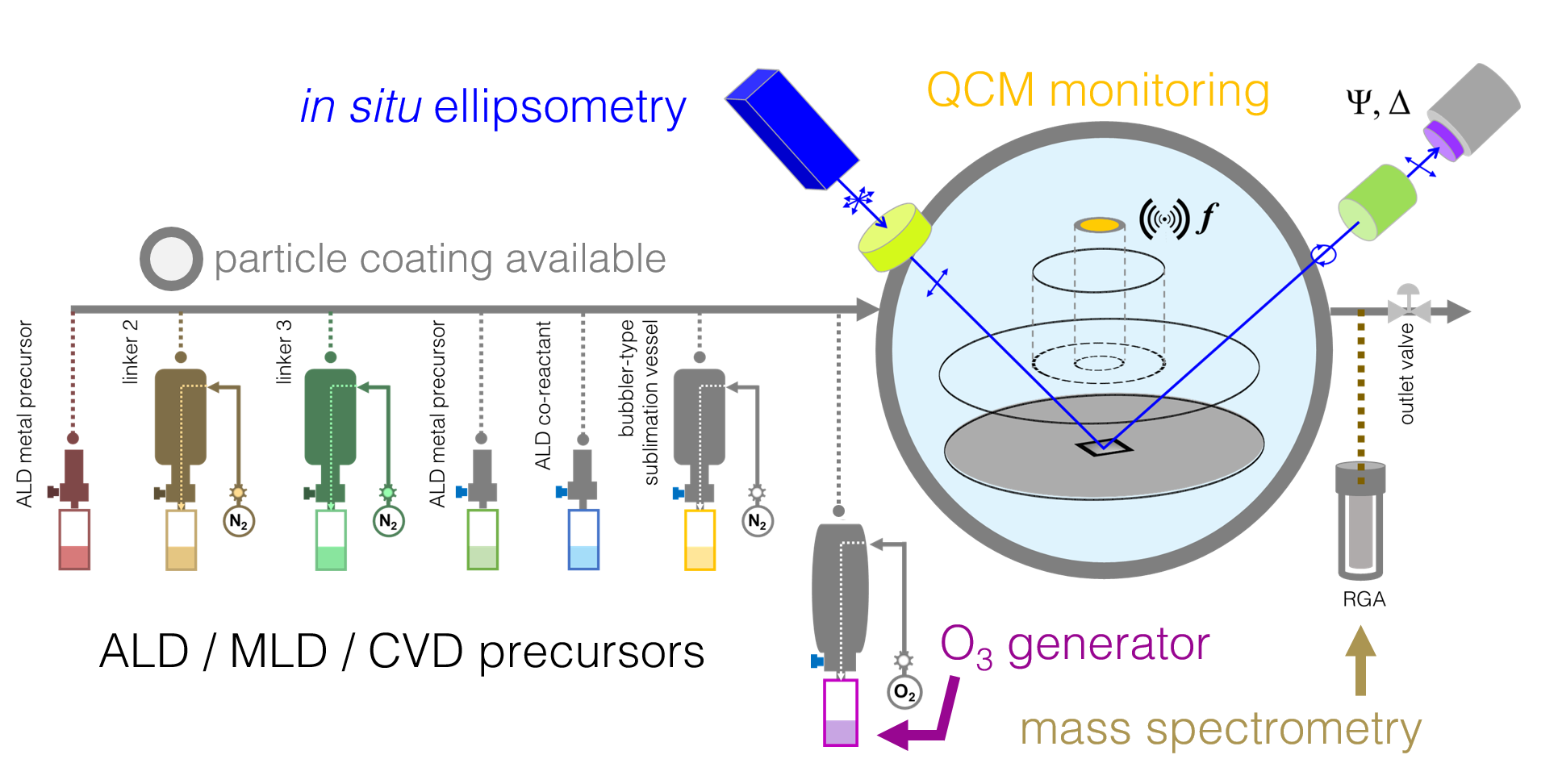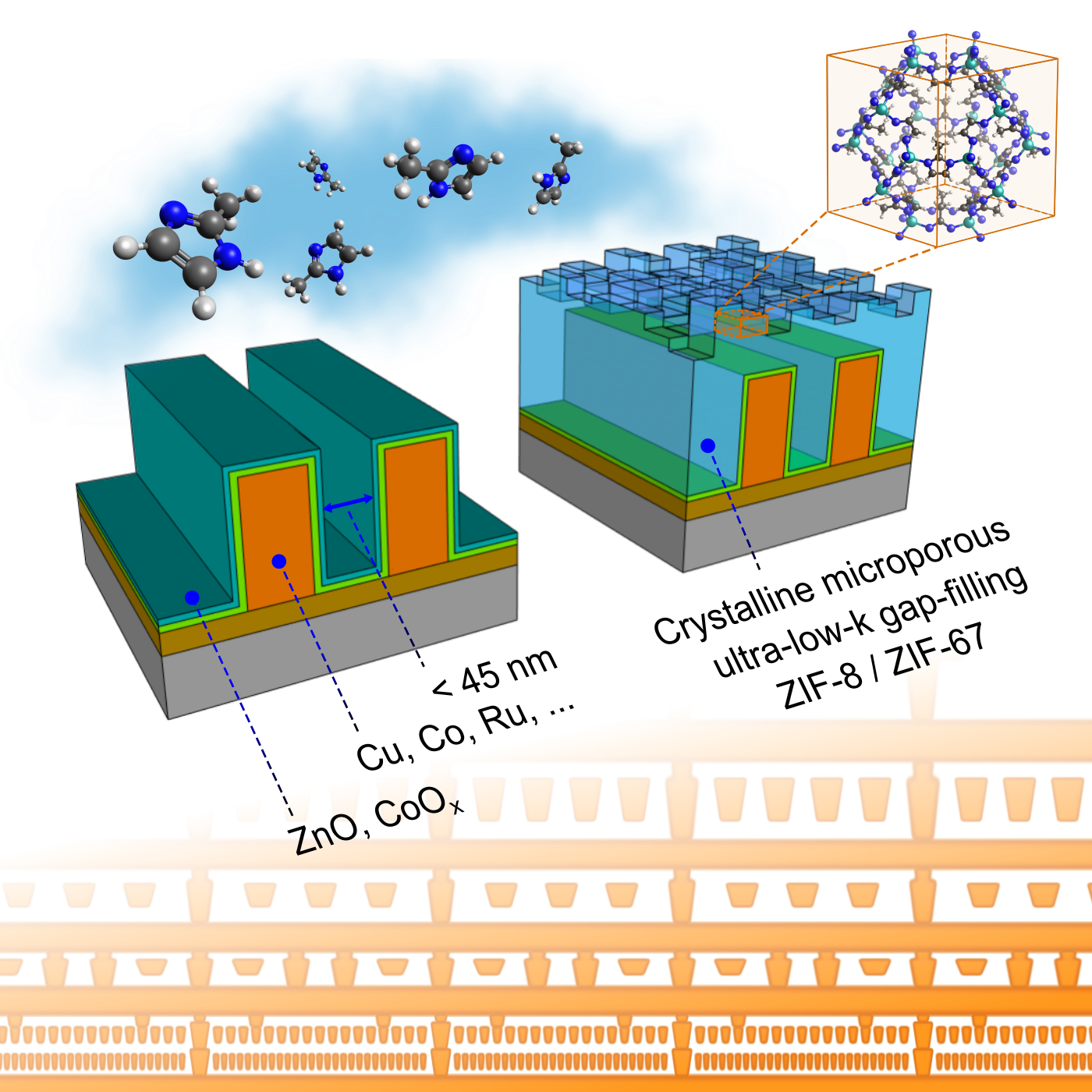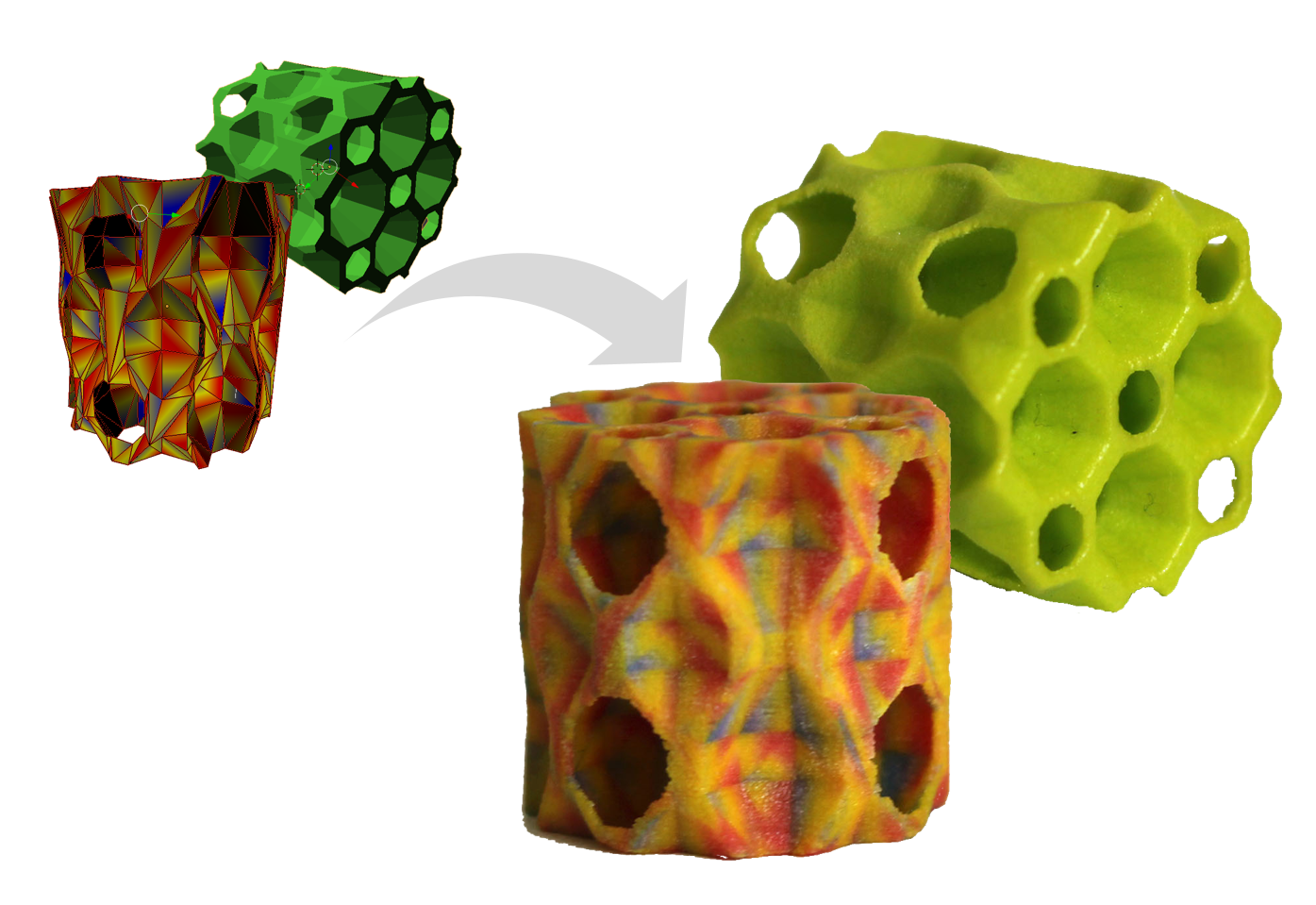Ameloot Group
Manipulating Porous Matter
Research
Metal-Organic Frameworks
Metal-organic frameworks (MOFs) are a class of porous crystalline solids, consisting of metal ion nodes held together by organic linkers. These materials have been intensely studied because of their record-breaking internal surface area, up to several football fields packed in a single gram of MOF material. Moreover, the organic functionality in MOFs enables engineering of the pore space truly at the molecular level.
We study several aspects of MOFs, ranging from their formation mechanisms to adsorption properties and stimuli-responsive behavior.
Example references
Marreiros, J., Caratelli, C., Hajek, J., Krajnc, A., Fleury, G., Bueken, B., De Vos, D., Mali, G., Roeffaers, M., Van Speybroeck, V., and Ameloot, R., The active role of methanol in post-synthetic linker exchange in the metal-organic framework UiO-66. Chemistry of Materials 31 (4), 1359–1369 (2019).
Stassen, I., Styles, M., Van Assche, T., Campagnol, N., Fransaer, J., Denayer, J., Tan, J.-C., Falcaro, P., De Vos, D. E., and Ameloot, R., Electrochemical Film Deposition of the Zirconium Metal-Organic Framework UiO-66 and Application in a Miniaturized Sorbent Trap. Chemistry of Materials 27, 1801-1807 (2015).
Stassen, I., Campagnol, N., Fransaer, J., Vereecken, P., De Vos, D. E., and Ameloot, R., Solvent-free synthesis of supported ZIF-8 films and patterns through transformation of deposited zinc oxide precursors. CrystEngComm 15, 9308 (2013)
What if the power of your pooch's nose could be integrated into your smart phone? YouTube link



Coatings of functional materials
A key enabling step in leveraging the properties of MOFs in microelectronics (as active sensor coatings, low-k dielectrics, etc.) will be the development of robust thin film deposition methods. Thus far, reported procedures for the deposition of MOF thin films are adaptations of powder preparation methods and typically involve the combination of linkers and metal salts in an organic solvent, often under solvothermal conditions. However, this approach is incompatible with microelectronic fabrication processes because of corrosion and contamination issues. Here is a YouTube link featuring our work on MOFs and (some of) its applications!
Chemical vapor deposition
We are developing thin film deposition methods for porous materials. Recently, we pioneered a chemical vapor deposition process to deposit highly conformal MOF coatings (‘MOF-CVD’) and has been translated to large-area substrates. The compatibility of MOF-CVD with existing microelectronics fabrication infrastructure will greatly facilitate MOF integration in microelectronics and related applications. We are also extending the protocol formulation via CVD to other MOF families.
Atomic and molecular layer deposition
We operate and maintain a heavily modified thermal atomic layer deposition reactor (based on a Savannah S200) in a class 6 cleanroom setting. The tool is able to cater substrates up to 200 mm in diameter and deposit ALD ZnO, CoOx, AlOx, and TiOx. Our reactor is equipped with in situ metrology tools such as spectroscopic ellipsometry, quartz crystal microbalance monitoring system, and residual gas analyzer. We are also developing new formulations towards molecular layer deposition of porous and crystalline coatings.
Example references
Cruz, A. J., Stassen, I. Krishtab, M., Marcoen, K., Stassin, T., Rodríguez-Hermida, S., Teyssandier, J., Pletincx, S., Verbeke, R., Rubio-Giménez, V., Tatay, S., Martí-Gastaldo, C., Meersschaut, J., Vereecken, P. M., De Feyter, S., Hauffman, T., and Ameloot, R., Integrated cleanroom process for the vapor-phase deposition of large-area zeolitic imidazolate framework thin films. Chemistry of Materials 31 (22), 9462−9471 (2019)
Tu, M., Reinsch, H., Rodríguez-Hermida, S., Verbeke, R., Stassin, T., Egger, W., Dickmann, M., Dieu, Bjorn., Hofkens, J., Vankelecom, I., Stock, N., Ameloot, R., Reversible Optical Writing and Data Storage in an Anthracene-Loaded Metal-Organic Framework. Angewandte Chemie-International Edition 58, 2423-2427 (2019)
Stassen, I., Burtch, N., Talin, A., Falcaro, P., Allendorf, M., and Ameloot, R., An updated roadmap for the integration of metal-organic frameworks with electronic devices and chemical sensors. Chemical Society Reviews 46, 3185-3241 (2017).
Stassen, I., Styles, M., Grenci, G., Gorp, H. V., Vanderlinden, W., Feyter, S. D., Falcaro, P., DeVos, D. E., Vereecken, P., and Ameloot, R., Chemical vapour deposition of zeolitic imidazolate framework thin films. Nature Materials 15, 304–310 (2016).
Dog's nose in your smartphone?
Check out our video @ Science Figured Out!

MOF-CVD ZIF-8: the first demonstration of controlled deposition of uniform and homogeneous large-area porous crystalline coatings

Robust reactor conforming to cleanroom standards

MOF-CVD for microelectronics integration: faster chips with porous crystalline interconnects
Additive manufacturing
The basic principle of additive manufacturing, often referred to as ‘3D printing’, is direct manufacturing of physical objects based on digital data. Objects are constructed by adding build material in layers, each one a thin cross-section of the 3D computer model of the item. The major ways in which current additive manufacturing techniques differ are in the materials that can be used and how layers are deposited and bonded.
We research several chemical aspects of 3D printing and how this exciting technology can be deployed to solve currently unexplored problems, in materials science and beyond.
3D-printer design
We design 3D-printers for materials development and prototyping. Here, a material extrusion-based 3D printer with plungers capable of printing multiple materials such as metal pastes to hydrogels. This design facilitates adding functionality to a wide array of 3D objects for various applications.
Design and animation prepared by Sander Van Herck, Pieter Standaert, and Thomas Marrecau (integrated bachelors’ projects students of the Bioscience Engineering program of KU Leuven, 2020) supervised Lore and Hanne from the 3D printing subgroup
Example references
Parra-Cabrera, C., Achille, C., Kuhn, S., and Ameloot, R., 3D printing in chemical engineering and catalytic technology: structured catalysts, mixers, and reactors. Chemical Society Reviews 47, 209-230 (2018).
Persembe, E., Parra-Cabrera, C., Clasen, C., and Ameloot, R., Binder-jetting 3D printer capable of voxel-based control over deposited ink volume, adaptive layer thickness, and selective multi-pass printing. Review of Scientific Instruments 92, 125106 (2021).
Fei, G., Nie, L., Zhong, L., Shi, Q., Hu, K., Parra-Cabrera, C., Oprins, H., Ameloot, R., and Yang, S., Photocurable resin-silica composites with low thermal expansion for 3D printing microfluidic components onto printed circuit boards. Materials Today Communications 31, 103482 (2022).
Vanduffel, H., Parra-Cabrera, C., Gsell, W., Oliveira-Silva, R., Goossens, L., Peeters, R., Himmelreich, U., Van Hooreweder, B., Sakellariou, D., Vanduffel, W., and Ameloot, R., Additive Manufacturing of Subject-Conformal Receive Coils for Magnetic Resonance Imaging. Advanced Materials Technologies 7 (12), 2200647 (2022).
Have a look at some of our shared designs that might be useful for you as well.


MRI scanner with a phantom
RECYCLEAR
With the RECYCLEAR project, we aim to expand the toolbox of modern resource management by incorporating novel technologies for industrial material detection and sorting. Our approach is purely multidisciplinary, leveraging the distinct properties of materials for their detection using smart computer science and mathematical engineering. Our objective is twofold: developing new identification methodologies while also aiming to streamline the lengthy value chain of secondary materials. We have initiated our journey by developing technology for plastics identification and more recently have begun addressing the detection of minority fibers in textile blends.
Take a look at our first technologies: the RECYCLEAR scanner, based on spectroscopy combined with AI, and the SUPERSORT platform, based on post-consumer tagging plastics with fluorescent markers after collection and shredding.
As an interdisciplinary project with a focus on industrialization, RECYCLEAR has thus far involved academics, companies, engineers, and students from diverse subject fields.
Have a look at our website for more information

